
Behavioral and Biochemical Effects of Pharmacopuncture (ST 21 and ST 40) in Obese Rats
*Corresponding Author(s):
Mariana Chiste PontesDepartment Of Biochemistry, Lysosomal Storage Diseases Laboratory, Universidade Federal Do Rio Grande Do Sul (UFRGS), Porto Alegre, Brazil
Tel:+55 51 33085550,
Email:janice.coelho@ufrgs.br
Abstract
Obesity is considered a disease of the century and several treatment methods have been researched. Traditional Chinese medicine describes several findings that can be used to treat this disease. Thus, the aim of the present study was to evaluate, from an experimental perspective of Western medicine, the biochemical and behavioral effects of pharmacopuncture (21 and 40) in obese Wistar rats. The HDP21 group, treated with pharmacopuncture, exhibited a reduction in body weight compared to controls, who were also fed a high-calorie diet. In the eating behavior test, the latency was lower in the HDP40 group, and in this group, animals consumed with a higher number of cereals compared to other obese groups, or with suggestions of high acupuncture or appetite in this group. The HDP21 group, on the other hand, exhibited the shortest time in closed arms when compared to the other groups, suggesting a reduction in anxiety. Regarding the perirenal fat weight and abdominal postmortem of groups fed a high calorie diet, the HDP21 group had the lowest weight of perirenal fat and abdominal fat compared to the others. Similarly, a reduction in cholesterol, triglyceride and glucose levels was observed in the HDP21 group compared to other groups that received a high calorie diet. In conclusion, the present study demonstrated the effectiveness of the pharmacopuncture that uses bee venom in ST21 with weight loss in obese rats, as well as the reduction in biochemical tests and with loss of anxiety.
Keywords
Eating behavior; Obesity; pharmacopuncture
INTRODUCTION
Human behavior in the 21st century and the facilitation of caloric consumption have resulted in an increase in the number of obese people worldwide. This phenomenon had already been an exponent in developed countries and, today, more and more, in developing countries [1]. Obesity is currently considered a serious epidemic and has been the target of several medical studies. Obesity is associated with diseases, among which cardiovascular diseases, diabetes mellitus, hyperlipidemia, tumors and infertility should be highlighted [2]. Obese patients have resistance to insulin and leptin, which further favors the maintenance of the disease [1]. The treatment for this disease is a challenge for medicine, which still does not have definitive healing techniques and a set of therapeutic methods has been used. In this sense, new therapeutic alternatives are being evaluated in the treatment of obesity [3]. Acupuncture is a technique of Traditional Chinese Medicine, which is increasingly spreading to the world in the treatment of many diseases, including obesity [4,5]. Among the acupuncture techniques, pharmacopuncture would be one of the methods used and it uses injection in the acupoints of drugs and substances. In pharmacopuncture there is a more prolonged stimulus of the acupoint, since the substance remains a period in the place, leading to organic reactions, before its absorption [6]. Several acupoints are indicated for the treatment of obesity, including those of the stomach meridian: Fenglong (st 40) and Liangmen (st 21) [4]. Thus, the objective of this study was to evaluate the biochemical and behavioral effects of pharmacopuncture at points st 40 and st21 in Wistar rats submitted to an obesity model previously described by our group [7].
MATERIAL AND METHODS
Twenty male Wistar rats with an average weight of 250 ± 10 g were used for each acupuncture point, in addition to 20 control animals. The animals were obtained from a monogamous Wistar colony maintained using the Poliey method of heterogeneous reproduction under a conventional controlled sanitary standard at the Vivarium of the UFRGS Biochemistry Department.
The “Principles of Laboratory Animal Care” (NIH publication nº85-2, revised 1985) were followed in all experiments and the experimental protocol was approved by the Animal Research Ethics Committee of the Federal University of Rio Grande do Sul, Porto Alegre.
The animals in this colony were kept in a standardized environment in polypropylene cages (414X344X168 mm) with stainless steel covers and autoclaved shavings under the 12-hour light / dark (07:00 / 19:00) photoperiod and controlled temperature (21?). The animals to be used in this study were kept under the same conditions, with five animals in each cage.
Water and food were provided ad libitum for three months prior to the experiment. The animals were divided into two groups containing 20 animals each: Group 1 (control), animals with a balanced diet; and Group 2 (obesity), obese animals previously treated with a high calorie diet.
Group 1 animals were fed water and a balanced diet ad libitum. Group 2 animals were fed a high calorie diet (Table 1) [8] throughout the experimental period. The diet was provided for 16 weeks (3 months), which led to significant weight gain.
|
Composition |
1,000g |
|
Comercial feed |
300 |
|
Condensed milk |
340 |
|
Hydrolyzed soy protein |
173 |
|
Sucrose |
80 |
|
Vitamin complex |
10 |
|
Mineral complex |
30 |
|
DL-Methionine |
3 |
|
Lysine |
2.5 |
|
Soybean oil |
60 |
Table 1: High-calorie diet.
The two experimental groups were divided into four subgroups that contained ten animals each: in the first, manipulation was used, in the second an unrelated point and in the third and fourth subgroups the pharmacopuncture was used in the acupoints (ST 21) and (ST 40 ).
In summary, the subgroups, with ten animals each, were as follows: SDH (Standard Diet and Handling), SDNO (Standard And Non-Point Diet), SDP40 (Standard Diet and Point 40), SDP21 (Standard Diet and Point 21) , HDH (High calorie Diet and manipulation), HDNP (High calorie and Non-Point Diet), HDP40 (High Calorie Diet and Point 40), and HDP21 (High calorie Diet and Point 21).
The procedure was performed once a day for 12 weeks, with pharmacopuncture with the application of bee venom (Sigma-Aldrich, 0.025 mg / kg), in a concentration of 0.01 mg / 0.05 ml. Each animal was administered approximately 0.05 ml, injected subcutaneously on the right side of the body. The syringe used was 0.45 x 13, with a 26G × ½ "needle. Body weight was measured before and after treatment.
Behavioral parameters were assessed after intervention with acupuncture using the elevated plus-maze test for anxiety assessment [9] and the eating behavior test to analyze motivation for food intake [10].
The elevated plus-maze test consists of evaluating the movement of the animals for five minutes on a cross-shaped apparatus with two arms with open sides and two arms with side walls that provide apparent protection for the animal. This test does not require prior exposure of the animal to the device.
The feeding behavior test is an analysis of the latency time for the animal to reach a container containing 16 units of Froot Loops® with eight different colors, being analyzed the latency time until the first bite, and the number of cereals consumed. The device consists of a 50 cm corridor in which the animal is placed for three minutes, on the opposite end of the bowl with the food. This test requires an adaptation of five days, so that the animal can adapt to the device and the new food.
At the end of the intervention period with the pharmacopuncture, the animals were weighed and euthanized using the guillotine method. Blood and adipose tissue samples were collected. Visceral fat (abdominal and perirenal) was removed and weighed.
Plasma triglycerides, glucose and cholesterol were evaluated using specific commercial kits from Labtest (Brazil) (Liquiform triglycerides, PAP Liquiform Glucose and Liquiform Cholesterol, respectively) to determine the final reaction point in the plasma after it was separated from the blood collected in tubes with EDTA by centrifugation at 2,000 rpm for ten minutes. Colorimetric enzymatic assays were the methods used for all analyzes, which was performed according to the manufacturer's instructions. The readings were taken by UV-Vis spectrophotometer with absorbance of 505 nm for triglycerides and glucose and 500 nm for cholesterol.
The statistical analysis used was ANOVA for the variation of body weight, body fat weight, and biochemical analyzes, while the Kruskal-Wallis test was used for behavioral analysis, with a significance level of 5%.
RESULTS AND DISCUSSION
The results of the use of pharmacopuncture in obese rats have been promising, as demonstrated in Pontes et al., [7]. This is a treatment that could be developed even in human studies, due to its positive results and the lack of a single effective therapy against obesity.
Some studies have demonstrated the effectiveness of pharmacopuncture in general [6,11-13] and there are still few studies of its applicability in obesity [7,11]. Next, the results of the pharmacopuncture effect at points st 21 and st 40 will be analyzed and discussed, based on the data obtained in the present study.
Obesity Model
The obesity model used in the present study, as described by Battú et al., [8], showed satisfactory results, since the groups that received the high-calorie diet obtained significantly greater weight gain (p <0.001) compared to the initial weight. Likewise, after 3 months of diet, the animals submitted to the high-calorie diet had significantly greater weight compared to the groups that received the standard diet (p <0.001) during the same period (Figure 1).
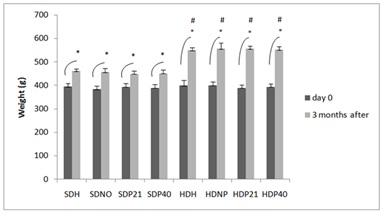
Figure 1: Body weight variation during the weight gain period * Significant difference (p <0.001) when compared to day 0. # Significant difference (p <0.001) when the groups that received a high calorie diet were compared with the groups of the standard diet.
All groups showed significant weight gain (p <0.001) after 3 months of treatment, with a gain of 16.38% for controls and 39.82% for animals that received a high calorie diet (obese group). The group of obese animals had a weight 17.1% greater than the control group at the end of treatment (p <0.001).
The data obtained in the present study corroborate with studies already developed, such as that of Zoth et al., [14], which obtained greater weight gains than that of the standard diet using a high-calorie diet with a higher concentration of fat. Likewise, Tian et al., [15] report a 50% gain in 14 weeks using a high calorie diet.
Variation in body weight
After 3 months of pharmacupuncture treatment (6 months after starting the diet), we observed that only the HDP21 subgroup exhibited a significant reduction in body weight (Figure 2).
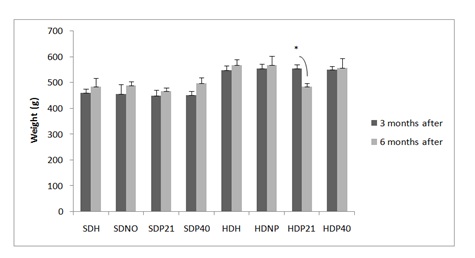 Figure 2: Variation in body weight during the treatment period * Significant difference (p <0.001) when compared before and after treatment in the HDP21 group.
Figure 2: Variation in body weight during the treatment period * Significant difference (p <0.001) when compared before and after treatment in the HDP21 group.
Several studies indicate the use of pharmacopuncture [7,11,16] acupuncture and electroacupuncture [3,17] for weight reduction body. However, none of the studies evaluated points st40 and st21 in isolation, using the pharmacopuncture technique in obese rats. This is the only work that assesses the effect of pharmacupuncture alone on these two acupoints. The results indicate that the pharmacupuncture isolated in acupoint st21 was able to decrease the body weight of this group of animals.
Behavioral Assessment
Eating behavior tests
The eating behavior test assesses appetite behavior. Thus, a lower latency to meet food indicates greater food appetite [10]. Of the 4 groups of animals submitted to a high calorie diet, 3 of them had a significantly longer latency time (p <0.001) to reach the food in relation to the groups that received the standard diet. The HDP40 subgroup exhibited significantly shorter latency times (p <0.001) for arrival at the froot loops in relation to the other obese groups, which demonstrates a greater appetite and interest in food compared to the other groups that received the high calorie diet. The high calorie diet alone may have inhibited the appetite of the HDH, HDNP and HDP21 groups. There was no significant difference between the HDP40 group and the groups that received the standard diet (Figure 3).
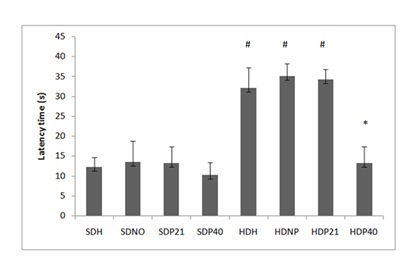 Figure 3: Test of eating behavior.
Figure 3: Test of eating behavior.
*Significant difference (p <0.001) in the HDP40 group when compared with the other obese groups # Significant difference (p <0.001) when compared with the groups that received the standard diet and the HDP40 group.
The application of pharmacupuncture in acupoint st40 for the treatment of obesity is always associated, in several studies, with other acupoints [18-20] which prevents a comparison of these results with those of the present study. The use of st40 alone in obese patients or even rats has not been evaluated in yet another study. The results obtained here seem to indicate that the pharmacupuncture isolated in acupoint st40 favors the food appetite of obese rats.
Due to the offer of a hyper-palatable diet, the consumption of froot loops by most groups of obese rats (Figure 4) was reduced and significantly lower in relation to the groups of animals that received the normal diet (p <0.001). However, the HDP40 group exhibited a higher consumption of froot loops compared to the others who also received the hyper-palatable diet (p <0.001), showing greater interest in this type of food compared to the others. The HDP40 subgroup also did not differ from the subgroups that received a standard diet (Figure 4). From these results, it is possible to conclude that the HDP40 group showed a greater appetite behavior than the other groups that were receiving a high calorie diet. These data were opposed to those found by other authors who used st40 in obese rats [18-20]. However, these authors did not use the st40 point in isolation, as in the present study, which may have masked the effect of stimulating this aspect.
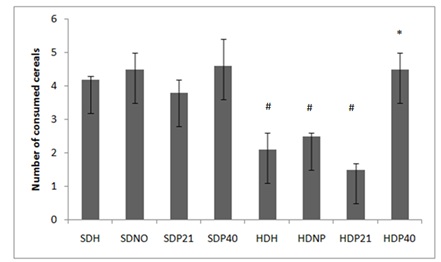 Figure 4: Eating behavior test.
Figure 4: Eating behavior test.
*Significant difference (p <0.001) of HDP40 when compared to other hypercaloric groups. # Significant difference (p <0.001) when compared with groups that received the standard diet and the HDP40 group.
Elevated Cross Test
The use of the elevated cross test assesses the animal's anxiety [21,22]. Thus, it is possible to verify if there is a correlation between obesity and anxiety, since anxious animals seem to have a greater chance of developing obesity.
The HDP21 subgroup had less time in the closed arm compared to the other subgroups (p <0.001), which indicates an anxiolytic action of st21 point stimulation (Figure 5). It has also been described by Belivani et al., [17] and Pontes et al., [7] anxiolytic action of the use of acupuncture in obese rats, but in other acupoints, and st21 had not yet been evaluated in isolation. These data suggest that the stimulus through pharmacopuncture with bee venom in acupoint st21 may promote anxiolytic action and may have a correlation with the weight loss observed in this group in the present study.
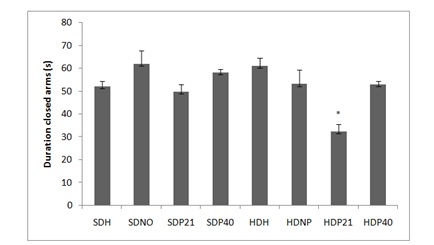 Figure 5: Elevated cross test.
Figure 5: Elevated cross test.
Time in the closed arm. *Significant difference (p <0.001) in the HDP21 group when compared to the other groups.
Visceral fat weight After 3 months of pharmacupuncture and the performance of behavioral tests, the animals were euthanized and the perirenal and abdominal fat was weighed, as well as the blood was removed for biochemical analyzes. When weighing visceral fat to observe the accumulation of adipose tissue, it was found that the groups that received a high-calorie diet exhibited significantly greater accumulation of perireal fat (p <0.001) compared to those that were submitted to the standard diet (Figure 6). Likewise, the HDP21 subgroup had a lower accumulation of this fat compared to the other subgroups that also received a high calorie diet (p <0.001), corroborating the previously mentioned weight reduction data (Figure 6).
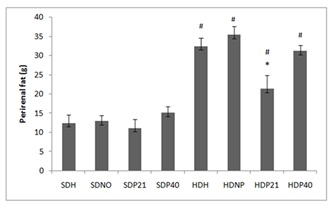 Figure 6: Post mortem perirenal fat.
Figure 6: Post mortem perirenal fat.
*Significant difference (p <0.001) in the HDP21 group when compared to the other groups that received a high calorie diet. # Significant difference (p <0.001) when compared to the other groups that received a standard diet.
There are reports of reduced perireal fat after using acupuncture [7,23,24]. However, in no work was the acupoint st21 evaluated in isolation, this being a new result.
The amount of abdominal fat was also higher in the groups that received a high-calorie diet (p <0.001), compared to the subgroups that received the standard diet. However, the HDP21 subgroup exhibited significantly lower results compared to the other groups that also received the hyper-palatable diet (p <0.001) (Figure 7).
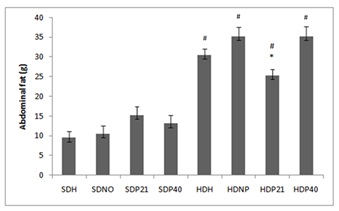 Figure 7: Post-mortem abdominal fat.
Figure 7: Post-mortem abdominal fat.
*Significant difference (p <0.001) in the HDP21 group when compared to the other groups that received a high calorie diet. # Significant difference (p <0.001) when compared to groups that received a standard diet.
The isolated use of pharmacupuncture in acupoint st21 has not been evaluated in other studies. However, the data obtained in the present study corroborate the results described by Kong et al., [24] and Wang et al., [23], in other acupoints evaluated in isolation using electroacupuncture. Likewise, in the present study, the results indicated that st40 did not influence the weight of the perirenal and abdominal fat of the analyzed rats.
Biochemical Analysis
After pharmacupuncture, it was found that the groups that received the high calorie diet had higher concentrations of plasma cholesterol compared to the groups that received the standard diet. The exception was the HDP21 group, which had lower cholesterol levels than the other groups that received the high-calorie diet (p <0.001) and did not differ from the levels presented by the groups that received the standard diet (Figure 8).
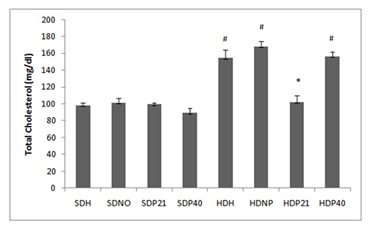 Figura 8: Colesterol Plasmático.
Figura 8: Colesterol Plasmático.
*Diferença significativa (p<0.001) do grupo HDP21 quando comparado com os outros grupos que receberam dieta hipercalórica. # Diferença significativa (p<0.001) quando comparado com os grupos que receberam dieta padrão.
Plasma glucose was significantly lower (p <0.001) in the subgroups that received the standard diet and in the HDP21 group compared to the other groups that received the high-calorie diet (Figure 9). These data are also compatible with the loss of body weight, which are related to the reduction of glycemic levels [25]. Although points st21 and st40 have not been studied in isolation by other authors, studies with other acupoints, such as those by El-Mekawy et al., [26], Pai et al., [27] and Pontes et al., [7], also showed a reduction of plasma glucose.
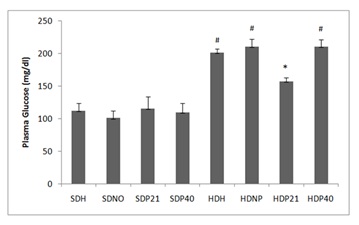 Figure 9: Plasma Glucose.
Figure 9: Plasma Glucose.
*Significant difference (p <0.001) of the HDP21 group when compared with the other groups that received a high calorie diet # Significant difference (p <0.001) when compared with the groups that received a standard diet.
Plasma triglyceride levels were also significantly lower (p <0.001) in the subgroups that received the standard diet and in the HDP21 subgroup compared to the other groups that received the high-calorie diet (Figure 10). There are no studies that have evaluated triglyceride levels after st21 and st40 acupuncture in obese rats. However, other studies using electroacupuncture in other acupoints have shown results in reducing triglycerides [7,23].
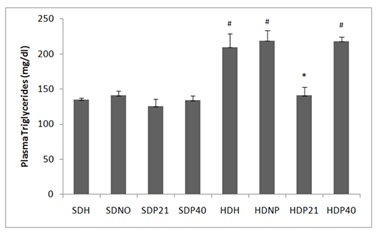 Figure 10: Plasma triglycerides.
Figure 10: Plasma triglycerides.
*Significant difference (p <0.001) of the HDP21 group when compared to the other groups that received a high calorie diet # Significant difference (p <0.001) when compared to the groups that received a standard diet.
The hypercaloric diet, therefore, interfered in the levels of plasma glucose, cholesterol and triglycerides. The obesity model showed satisfactory results, since the animals that received the high-calorie diet exhibited these high biochemical parameters, when compared with those animals that received the standard diet. These results are in line with those obtained by the models described by Rosini et al., [28], Burneiko et al., [29] and De Moraes et al., [30].
In this work it was found that the pharmacupuncture at point st21 promoted a reduction in body weight and anxiolytic activity in the animals studied, which may have helped in the reduction of biochemical parameters, such as glucose, cholesterol and plasma triglycerides. As there was no reduction in body weight for the HDP40 group, the variables of cholesterol, glucose and plasma triglycerides did not change significantly in relation to the other groups that also received the high-calorie diet, with this group also having an inverse effect, with the increase in appetite behavior.
CONCLUSION
The present study concludes that phamacupuncture at point st21 showed favorable results in reducing body weight, visceral fat and biochemical parameters such as cholesterol, glucose and triglyceride levels in obese rats. Likewise, these animals' anxiety decreased as shown by the behavioral test.
CONFLICT OF INTERESTS
The authors state that they have no conflict of interest in publishing this article. Research support did not play any role in the study project; data collection, analysis and interpretation; in writing the article; or in the decision to send the article for publication.
AUTHORS' CONTRIBUTIONS
MP did pharmacupuncture, animal handling, behavioral tests and biochemical analyzes. JCC participated in the design of the study, carrying out statistical tests and coordinating the work. The authors read and approved the manuscript.
THANKS
The authors thank CAPES and CNPq for the financial support granted.
REFERENCES
- Morrisa MJ, Beilharza JE, Maniama J, Reichelta AC, Westbrookb RF (2014) Why is obesity such a problem in the 21st century? The intersection of palatable food, cues and reward pathways, stress, and cognition. Neurosci Biobehav Rev 58: 36-45.
- Maeso FM, Brito DB, Cabrera DLA (2006) Leptin, estrogens and cancer. Mini Rev Med Chem 6: 897-907.
- Cho SH, Lee JS, Thabane L, Lee J (2009) Acupuncture for obesity: a systematic review and meta-analysis. Int J Obes 33: 183-196.
- Lacey JM, Tershakovec AM, Foster GD (2003) Acupuncture for the treatment of obesity: a review of the evidence. International Journal of Obesity 27: 419-427.
- Kowalski GM, Bruce CR (2014) The regulation of glucose metabolism: implications and considerations for the assessment of glucose homeostasis in rodents. Am J Physiol Endocrinol Metab 307: 859-871.
- Strudwick MW, Hinks RC, Choy STB (2007) Point injection as an alternative acupuncture technique—an exploratory study of responses in healthy subjects. Acupunct Med 25: 166-174.
- Pontes MC, Heck LC, Coelho JC (2015) Behavioral and biochemical effects of pharmacopuncture (ST 36 and ST 25) in obese rats. BMC Complementary and Alternative Medicine 15: 297.
- Battú CE, Rieger D, Loureiro S, Furtado GV, Bock H, et al. (2012) Alterations of PI3K and Akt signaling pathways in the hippocampus and hypothalamus of Wistar rats treated with highly palatable food. Nutr Neurosci. 15: 10-17.
- Carobrez AP, Bertoglio LJ (2005) Ethological and temporal analyses of anxiety-like behavior: The elevated plus-maze model 20 years on. Neuroscience and Biobehavioral Reviews 29: 1193-1205.
- Noschang CG (2009) Cafeína e estresse : influências sobre o comportamento e sobre parâmetros bioquímicos avaliando estresse oxidativo no sistema nervoso central. Lume inicial – UFRGS, Brasil.
- Lim CS, Park WP, Jang SB (2008) Clinical studies of sweet bee venom to the effect of abdominal fat accumulation. J Pharmacopunct 11: 33-40.
- Luna SP, Angeli AL, Ferreira CL, Lettry V, Scognamillo-Szabó M (2008) Comparison of pharmacopuncture, aquapuncture and acepromazine for sedation of horses. Evid Based Complement Alternat Med 5: 267-272.
- Kwon K, Kim S, Kim C (2011) 2ndedn, Elsevier.
- Zoth N, Weigt C, Laudenbach-Leschowski U, Diel P (2010) Physical activity and estrogen treatment reduce visceral body fat and serum levels of leptin in an additive manner in a diet induced animal model of obesity. Journal of Steroid Biochemistry & Molecular Biology 122: 100-105.
- Tian DR, Li XD, Wang F, Niu DB, He QH, et al. (2005) Up-regulation of the expression of cocaine and amphetamine-regulated transcripted peptideby eletroacupuncture in the arcuate nucleus of diet-induced obese rats. Neuroscience letters 383: 17-21.
- Lim CS, Park SK, Sun SH, Lee KH (2014) Research on Korean Pharmacopuncture in South Korean since J Pharmacopunct 17: 15-21.
- Belivani M, Dimitroula C, Katsiki N, Apostolopoulou M, Cummings M, et al. (2013) Acupuncture in the treatment of obesity: a narrative review of the literature. Acupunct Med 31: 88-97.
- Pang T, Liu Z, Xu B (2015) Clinical observation on obesity and hyperlipidemia of yang deficiency of spleen and kidney syn- drome in female patients treated with warm acupuncture combined with auricular acupuncture. Zhongguo Zhen Jiu 35: 529-33.
- Liang CM, Hu H, Li YY (2012) Acupuncture treatment of abdominal obesity patients by belt vessel (Daimai) regulating method. Zhen Ci Yan Jiu 37: 493-496.
- Sun DY, Sun LH, Liang YL, Zhang SY, Xiao HL, et al. (2010) Effect of electroacupuncture on lipid metabolism in male and female obesity rats. Zhen Ci Yan Jiu 37: 206-210.
- Carobrez AP, Bertoglio LJ (2005) Ethological and temporal analyses of anxiety-like behavior: The elevated plus-maze model 20 years on. Neuroscience and Biobehavioral Reviews 29: 1193-1205.
- Oliveira CD, Oliveira CM, de Macedo IC, Quevedo AS, Filho PR, et al. (2015) Hypercaloric diet modulates effects of chronic stress: a behavioral and biometric study on rats. Stress 18: 514-523.
- Wang F, Tian, ED, Han, EJ (2008) Electroacupuncture in the Treatment of Obesity. Neurochem Res 33: 2023-2027.
- Kong XJ, Gao L, Peng H, Shi X (2010) Effects of electro-acupuncture on expression of obestatin in hypothalamus of rats with simple obesity. Zhong Xi Yi Jie He Xue Bao 8: 480-485.
- Shen W, Wang Y, Lu S, Hong H, Fu S, et al. (2014) Acupuncture promotes white adipose tissue browning by inducing UCP1 expression on DIO mice. BMC Complementary and Alternative Medicine 14: 501.
- El-Mekawy HS, Eldeeb AM, Ghareibb HO (2015) Effect of laser acupuncture combined with a diet-exercise intervention on metabolic syndrome in post-menopausal women. J Adv Res 6: 757-763.
- Pai H, Tzeng C, Lee Y, Chang C, Lin J, et al. (2009) Increase in Plasma Glucose Lowering Action of Rosiglitazone by Electroacupuncture at Bilateral Zusanli Acupoints (ST.36) in Rats. J Acupunct Meridian Stud 2: 147-
- Rosini TC, Silva ASR, Moraes C (2012) Obesidade induzida por consumo de dieta: modelo em roedores para o estudo dos distúrbios relacionados com a obesidade. Rev Assoc Med Bras 58: 383-387.
- Burneiko RC, Diniz YS, Galhardi CM, Rodrigues HG, Ebaid GM, et al. (2006) Interaction of hypercaloric diet and physical exercise on lipid profile, oxidative stress and antioxidant defenses. Food Chem Toxicol 44: 1167-1172.
- De Moraes C, Davel AP, Rossoni LV, Antunes E, Zanesco A (2008) Exercise training improves relaxation response and SOD-1 expression in aortic and mesenteric rings from high caloric diet-fed rats. BMC Physiol 29: 8-12.
Citation: Pontes MC, Coelho JC (2020) Behavioral and Biochemical Effects of Pharmacopuncture (ST 21 and ST 40) in Obese Rats. J Altern Complement Integr Med 6: 128.
Copyright: © 2020 Mariana Chiste Pontes, et al. This is an open-access article distributed under the terms of the Creative Commons Attribution License, which permits unrestricted use, distribution, and reproduction in any medium, provided the original author and source are credited.

